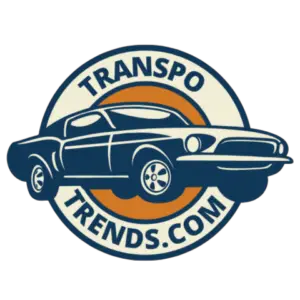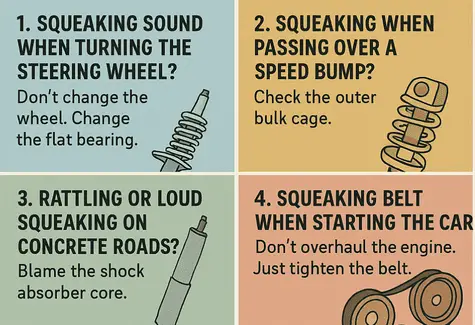Every car tells a story. But when mine began to squeak every time I turned the steering wheel or drove over a speed bump, it started sounding more like a horror film than a smooth ride.
At first, I panicked—because let us be honest, most of us have had that moment where a strange noise from under the hood sent us straight to the mechanic, only to be handed a bill that could easily double as a down payment.
Today, I am here to save you from that fate.
Let me walk you through how I solved five common squeaking issues in my car for less than the cost of a single oil change—no unnecessary parts replaced, no exaggerated diagnoses. Just practical solutions that anyone can act on.
1. Squeaking Sound When Turning the Steering Wheel? Do Not Change the Wheel. Change the Flat Bearing.
The first sign of trouble came when I started noticing a faint but persistent squeak whenever I turned the steering wheel. Naturally, the fear sets in—was the steering column going bad? Would I need a full steering rack replacement?
Not quite. Upon checking with a knowledgeable mechanic and doing some research, the issue was traced to a flat bearing on the shock absorber. The steering system passes force through the suspension, and when the bearing on the top of the shock absorber wears out, it can cause friction and noise.
Cost of Repair: Only $8.
Solution: Replace the flat bearing on the shock absorber. It is a simple component, typically located where the strut assembly meets the chassis. You can even find video tutorials that walk you through it if you are handy with tools.
2. Squeaking When Passing Over a Speed Bump? Check the Outer Bulk Cage.
This one baffled me for a while. Every time I crossed a speed bump, it sounded like the car was complaining about my choice of roads. At first, I assumed the shock absorbers were worn out, but a deeper inspection showed that the issue was with the outer bulk cage.
The outer bulk cage, or sometimes referred to as the stabilizer link housing, can wear down or become loose, especially if you regularly drive on uneven surfaces. This allows metal-on-metal contact, which results in a sharp squeak or creak.
Cost of Repair: $17.
Solution: Replace the outer bulk cage. It takes under an hour to swap it out if you have access to basic tools. The change was immediate and noticeable—my car stopped sounding like a rusty trampoline.
3. Rattling or Loud Squeaking on Concrete Roads? Blame the Shock Absorber Core.
If you frequently drive on textured concrete surfaces, you may notice a hollow rattle or squeak that seems to resonate through the entire cabin. This type of noise often comes from worn-out shock absorber cores.
The shock absorber core helps to cushion the ride, and when it wears down, it cannot control the rebound properly. As a result, you get bouncing, squeaking, and a less stable ride.
Cost of Repair: $7.
Solution: Replace the shock absorber core. Most automotive stores carry compatible parts based on your car make and model. Once installed, the sound vanished completely.
4. Squeaking Belt When Starting the Car? Do Not Overhaul the Engine. Just Tighten the Belt.
There is nothing quite like starting your car in the morning and being greeted with a loud, embarrassing squeal from the engine bay. Many shops will suggest a full engine inspection or pulley replacement.
But in most cases, especially with older cars or those sitting unused for a while, the issue lies with the drive belt or serpentine belt. It may be slightly loose or have some residue built up.
Quick Test: Pour a little water on the belt. If the squeak temporarily disappears, it confirms belt slippage.
Cost of Repair: Virtually free if you already own basic tools.
Solution: Tighten the belt using the adjustment bolt or tensioner. If it is cracked or glazed, consider replacing it, but do not let anyone talk you into an engine rebuild over a belt squeak.
Summary
| Symptom | Suspected Issue | Part to Replace | Cost Estimate | Solution Summary |
|---|---|---|---|---|
| Squeaking when turning steering wheel | Worn bearing on strut mount | Flat bearing | $8 | Replace bearing on shock absorber |
| Squeaking when crossing speed bumps | Loose outer stabilizer part | Outer bulk cage | $17 | Replace the outer cage housing or stabilizer link |
| Rattling noise on concrete roads | Degraded damping core | Shock absorber core | $7 | Replace the internal shock core |
| Chirping sound when starting the engine | Loose or worn drive belt | Drive belt (or retension) | Free–$10 | Test with water, then tighten or replace belt if necessary |
Final Thoughts
Your car’s squeaks are often not a sign of catastrophic failure, but rather a call for attention to small, replaceable components.
While repair shops are essential and provide vital services, not every solution requires a deep wallet. Sometimes, all you need is a sharp ear, a bit of patience, and a willingness to learn.
For more detailed breakdowns of car noises and DIY repairs, consult your vehicle’s service manual.

